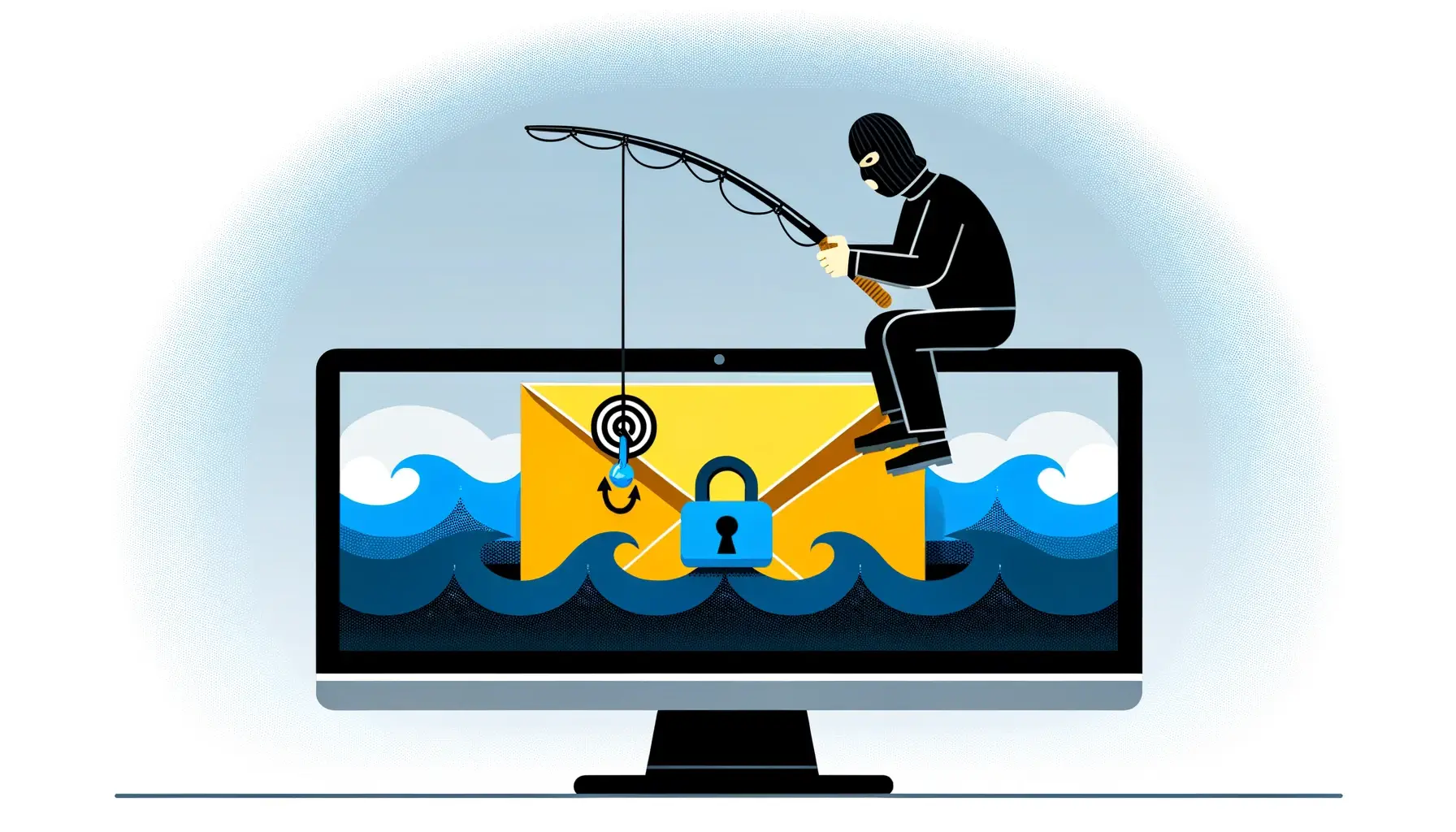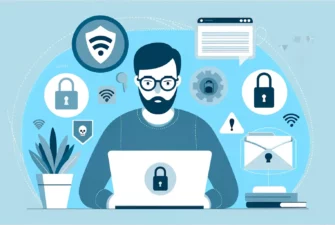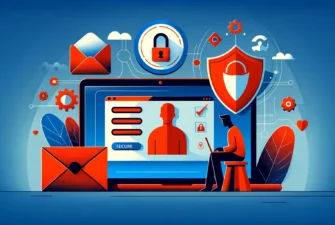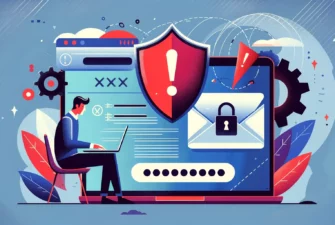
Scamming people is nothing new. Impostors like Victor Lustig and Frank Abagnale have long exploited trust and played mind games with their victims. From selling the Eiffel Tower twice to impersonating a pilot, their cons were legendary. In today’s digital age, scammers find fertile ground on the Internet.
A striking example is Evaldas Rimasauskas, a Lithuanian man who deceived Google and Facebook into sending him over $100 million. Posing as Quanta Computer, a Taiwanese electronics manufacturer, Rimasauskas compromised the security of these tech giants, revealing the dangerous threat of phishing.
Phishing is one of the oldest tricks in online scammers’ books. Why spend countless hours on breaking highly secure systems, when a well-crafted email can persuade the target to voluntarily handle everything you request? This article covers phishing in great detail and provides tips on how to prevent a phishing attack.
Table of Contents
- What Is Phishing?
- How Does Phishing Work?
- What Types of Phishing Scams Exist?
- How to Recognize a Phishing Attack?
- How to Stop Phishing Emails?
- What to Do if You Gave Your Information or Money to a Phishing Scammer?
- Why Is It Important to Avoid Phishing Emails?
What Is Phishing?
Phishing is a cyber-attack where scammers attempt to deceive individuals into providing sensitive information such as passwords, credit card numbers, or social security numbers, by masquerading as trustworthy entities. The ultimate goal is to gain unauthorized access to personal or financial data and use it for malicious purposes, such as identity theft or financial fraud.
The term “phishing” is derived from the word “fishing.” It was coined as a play on words because phishing attacks share similarities with the act of fishing. Just as traditional fishing uses bait to hook fish, phishing attacks employ fraudulent communications to lure unsuspecting individuals into revealing their sensitive information.
The term was first used in the mid-nineties by hackers and researchers on early online platforms, such as AOL. However, it gained wider recognition and usage in the early noughties as phishing attacks became more prevalent and a serious cybersecurity threat.
How Does Phishing Work?
Phishing works by using various tactics to appear trustworthy and legitimate. Scammers often send fraudulent emails, and text messages or even make phone calls pretending to be someone else, like a bank representative, a social media platform, or an online retailer. They use clever techniques to manipulate people into taking actions, like clicking on a malicious link or downloading infected attachments.
Phishing Attempt Example
Let’s take a closer look at how phishing works with a concrete example:
Imagine you receive an email that appears to be from your bank. The email might use the bank’s logo and official colors and even mimic the format. The subject line could be urgent, suggesting a problem with your account or the detection of a suspicious transaction.
Within the email, there will usually be a call to action that urges you to resolve the issue. For instance, it might ask you to click a link to verify your account details or identity. However, the link provided will not lead you to the actual bank’s page but to a cleverly designed malicious website that closely resembles the bank’s legitimate site.
Once you click on the link and arrive at the fake website, you will see a login page that looks identical to the bank’s genuine login page. If you enter your username and password on this page, the scammers will capture that information.
In some cases, after entering your credentials, you may be redirected to the bank’s website to create the illusion that nothing suspicious has occurred. By doing this, the scammers try to avoid raising any immediate red flags.
With the login information obtained, the attackers can access your bank account, make unauthorized transactions, or even sell your credentials on the dark web to other criminals.
What Types of Phishing Scams Exist?
Phishing scams are diverse and evolving. Attackers search for new ways to run their mischievous schemes, but the underlying strategy is constant. Here are some common phishing scams you should know:
1. Email Phishing
Email is the classic form of phishing. Scammers send emails that appear to come from a legitimate source, such as a bank or an online service provider. The emails usually contain a sense of urgency, asking recipients to update their account information or verify their credentials by clicking on a link that leads to a fake website. For example, you might receive an email claiming to be from a service provider, asking you to click on a link and enter your login credentials to resolve an issue with your account.
2. Business Email Compromise (BEC)
BEC attacks target businesses and involve impersonating high-ranking executives or trusted vendors to deceive employees into performing unauthorized actions. Scammers typically send emails that appear to come from a CEO, CFO, or a known vendor, instructing employees to initiate wire transfers, disclose sensitive data, or make changes to payment details. These attacks exploit the trust and authority associated with executives or vendors, making it more likely for employees to comply with fraudulent requests.
3. Spear Phishing
Spear phishing targets specific individuals or organizations by tailoring the attack to their personal or professional interests. Fraudsters gather information about their targets through social media or other sources to create personalized and convincing messages. For instance, a scammer might email an employee of a company, posing as a senior executive and requesting sensitive company information.
4. Smishing and Vishing
Smishing refers to phishing attacks conducted through text messages, while vishing refers to voice phishing over phone calls. Scammers send text messages or make phone calls impersonating trusted entities, like banks, tech support, or government agencies, and try to trick individuals into sharing their personal information or making financial transactions over the phone.
5. Pharming
In pharming attacks, attackers manipulate the domain name system (DNS) to redirect users to fraudulent phishing sites without their knowledge. Unlike traditional phishing attacks that rely on tricking individuals through deceptive emails or links, pharming attacks tamper with the fundamental infrastructure of the internet.
Scammers compromise the DNS settings by exploiting vulnerabilities in DNS servers or infecting users’ computers with malware. This way, they redirect the traffic intended for legitimate websites to fake websites that closely resemble legitimate ones. When users type in the correct website address or click on a bookmarked link, the pharming attack directs them to the malicious website.
How to Recognize a Phishing Attack?
Here are some proven ways to recognize phishing attacks, along with improvements to the existing points:
- Urgency and Fear Tactics: Phishing emails often create a sense of urgency or use fear tactics to pressure you into taking immediate action. They may claim that your account will be closed or you’ll face consequences if you don’t respond quickly. Be cautious of such tactics and carefully evaluate the situation before providing any sensitive information.
- Unexpected Attachments: Phishing emails sometimes contain unexpected attachments, such as invoices, shipping details, or legal documents. These attachments may contain malware or viruses that can compromise your computer or steal your data. Avoid opening attachments from suspicious or unknown sources.
- Unusual Requests for Information: Be wary of emails that ask for unnecessary personal or financial information. Legitimate organizations typically don’t request sensitive information via email, especially login credentials, social security numbers, or credit card details. Contact the organization directly through their official website or customer support channels to verify the request.
- Generic Greetings or Lack of Personalization: Phishing emails often use generic greetings like “Dear Customer” instead of addressing you by your name. Genuine companies usually personalize their emails and use your name or username to establish authenticity. Be suspicious of emails that do not address you personally.
- Spoofed Email Addresses: Pay attention to the email address from which the message comes. Phishing scammers can spoof email addresses to make it appear it’s coming from a legitimate source. Check the email address carefully for any slight variations or misspellings that may indicate a fraudulent sender.
- Unexpected or Unfamiliar Senders: Exercise caution if you receive an email from someone you don’t recognize or have no previous communication with. Be especially wary if the email claims to be from a well-known organization or individual but does not align with your existing interactions or expectations.
- No digital signature: A digital signature verifies the identity of the sender. Acting similarly to SSL certificates, digital email certs enable end-to-end encryption of your communications. You can check the status of an incoming email from your client. The green checkmark and verified email address indicate that the message has been digitally signed by a trusted Certificate Authority.
How to Prevent a Phishing Attack?
Phishing email prevention, whether you’re a client or an impersonated company, is all about being proactive. Listed below are ten efficient ways to avoid phishing:
- Enable Two-Factor Authentication (2FA): Add an extra layer of security to your credentials and passwords by enabling 2FA. It requires an additional step, such as entering a code sent to your mobile device or using biometric authentication like fingerprints.
- Use Email Certificates: Protect your personal or business identity by digitally signing your email exchanges with email certificates. These certificates, provided by trusted Certificate Authorities like Sectigo and Digicert, encrypt your outgoing emails and documents, ensuring sender legitimacy.
- Implement Email Authentication Protocols: Utilize email authentication protocols like SPF (Sender Policy Framework), DKIM (DomainKeys Identified Mail), and DMARC (Domain-based Message Authentication, Reporting, and Conformance) to help prevent email spoofing and ensure that incoming emails are from legitimate sources.
- Be Cautious of Unsolicited Communications: Be wary of unsolicited emails, especially those requesting sensitive information or urging immediate action. Contact the sender through its official website or customer support channels to confirm email authenticity.
- Regularly Update and Secure Devices: Install the latest security patches and antivirus software. Regularly applying updates helps protect against known vulnerabilities that phishers may exploit.
- Educate Yourself and Stay Informed: Become aware of the phishing techniques and evolving threats, including phishing trends, tactics, and red flags. Stay informed through reliable sources, such as security blogs and news outlets.
- Secure Network Connections: Use a secure network connection when accessing sensitive information or making online transactions. Avoid using public Wi-Fi networks for such activities, as they may lack proper encryption and can be vulnerable to eavesdropping.
- Be Wary of Suspicious Links and Attachments: Avoid clicking on suspicious links or downloading attachments from unknown or untrusted sources. Hover over links to inspect the URL before clicking.
- Regularly Monitor Financial and Online Accounts: Keep a close eye on your financial and online accounts for any unauthorized activity. Regularly review bank statements, credit card transactions, and online account activities to detect and report suspicious or fraudulent transactions.
- Report Phishing Attempts: Make the Web safer by reporting phishing emails to relevant authorities, such as [email protected] and [email protected]. Revealing such attempts helps them take action against phishing campaigns and protects others from falling victim to them.
How to Stop Phishing Emails?
The best way to prevent phishing scams is to be cybersecurity aware. Employ robust email filtering and spam detection software or services to detect and block phishing emails. These systems use advanced algorithms and databases of known phishing indicators to identify and filter out suspicious emails before they reach your inbox.
But even the best spam filters may sometimes miss phishing messages. That’s why it’s essential to foster a culture of vigilance among employees and users by encouraging them to scrutinize emails for signs of phishing. Promptly report suspected phishing emails to IT or security teams, enabling them to block malicious senders or domains.
What to Do if You Gave Your Information or Money to a Phishing Scammer?
If you realize you have given your information or money to a phisher, take immediate action to mitigate any potential damage. Time is of the essence, so the faster you respond, the better chance you have of minimizing the impact.
Immediately change the passwords for any accounts you believe may have been compromised. Start with your email, online banking, social media, and other critical platforms. Create strong, unique passwords for each account to enhance security.
Next, contact and inform the organizations or financial institutions impacted by the scam about the fraudulent activity and provide any relevant details. They can guide you on the necessary steps to secure your accounts and prevent further unauthorized access.
Monitor your bank statements, credit card transactions, and other accounts for suspicious activity. Report any unauthorized transactions to your bank or credit card company immediately.
And inform your local enforcement agency or the cybercrime division about the fraud.
After a phishing incident, scammers may attempt to target you again, posing as representatives from the organization you were scammed by. Stay vigilant and be wary of any dubious communications, especially those requesting further personal information.
Finally, ensure your computer and devices have up-to-date antivirus and anti-malware software installed. Run a thorough scan to detect and remove any potential malware that entered your systems during the phishing attack.
Why Is It Important to Avoid Phishing Emails?
Nowadays, phishing is ubiquitous and anyone can become its victim. From the healthcare industry to individuals, no one is immune to online scams. A new phishing site is launched every 20 seconds, while 86% of email attacks don’t contain malware. Businesses and organizations rely on the trust and confidentiality of their clients. Falling victim to a phishing attack can compromise customer data, erode trust, and harm the reputation beyond repair.
Below we’ve listed a few eye-opening stats you probably didn’t know about phishing:
- Phishing accounts for 90% of data breaches and is the most common form of cybercrime, with an estimated 3.4 billion spam emails sent every day.
- According to the FBI losses resulting from business email compromise and email account compromise have exceeded $43 billion.
- Over 48% of emails sent in 2022 were spam.
- The average cost of a data breach against an organization is more than $4 million.
- In January 2017, a Gmail phishing scam targeted nearly 1 billion users worldwide
- 37.9% of Untrained Users Fail Phishing Tests
- Apple is the most imitated company for phishing scams
As you can see, email phishing is a serious threat that is impossible to wipe out completely. As long as the Internet exists, phishers will find clever ways to manipulate users and businesses. That’s why you should always be aware and alert when opening and managing your emails. Phishing prevention is not difficult. You can spot and ignore a potential scam in no time if you train yourself to do it.
Conclusion
We’ve given you all the tools and knowledge on how to prevent a phishing attack. Now, it’s up to you to follow the recommendations and spot any malicious activity before it takes advantage of your carelessness.
Avoiding phishing emails is vital for safeguarding personal information, financial resources, digital security, and maintaining trust in online interactions. By staying alert and employing safe practices, you can protect yourself and contribute to a more secure digital environment.
Frequently Asked Questions
Phishing is difficult to prevent because scammers continuously evolve their techniques, making it challenging for security measures to keep up and detect every phishing attempt effectively.
Copy Link
Phishing targets individuals and organizations across various industries, including banking, e-commerce, healthcare, and government, to obtain sensitive information or financial gain.
Copy Link
Phishing happens because it’s a lucrative and relatively low-risk method for cybercriminals to exploit human vulnerabilities, bypass security measures, and deceive individuals into divulging confidential information or performing harmful actions.
Copy Link
The duration of a phishing campaign can vary, ranging from a few hours to several weeks, depending on the specific goals and tactics of the attacker.
Copy Link
Yes, phishing is typically carried out by hackers or cybercriminals who use social engineering techniques, fake websites, and fraudulent communications to deceive and exploit individuals or organizations.
Copy Link
While simply opening an email is unlikely to directly hack your device, phishing emails often contain malicious links or attachments that, when opened, can lead to malware infections or further compromise your security.
Copy Link
It’s challenging to eliminate phishing due to the sheer amount of attacks that occur daily. The best approach is to be vigilant in every online interaction be it via email, social media, or chat.
Copy Link
Save 10% on SSL Certificates when ordering today!
Fast issuance, strong encryption, 99.99% browser trust, dedicated support, and 25-day money-back guarantee. Coupon code: SAVE10



























